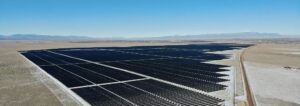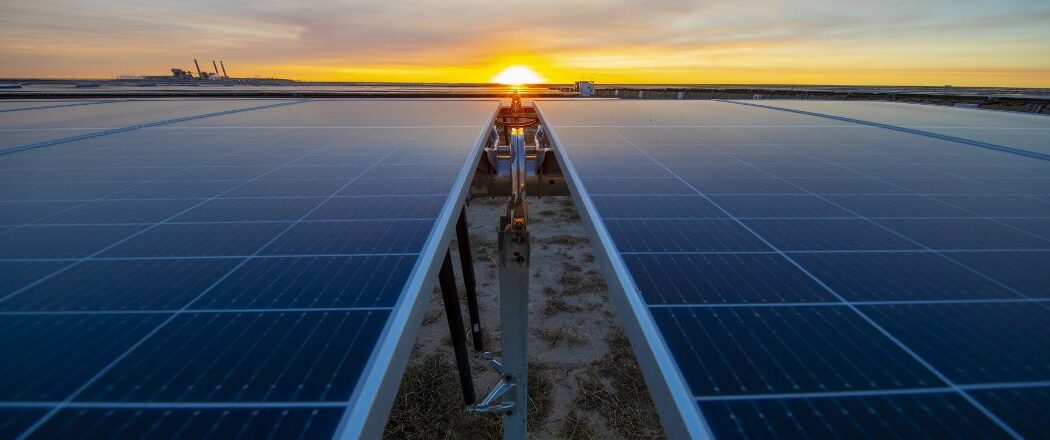Long-term REVITALIZATION readers have seen many innovative, multi-function solar energy projects over the past decade, among our 10,000+ articles.
In Gujarat, India, we saw how an agency charged with distributing irrigation wat to farmers drastically cut the evaporation of that water from their canals by covering the canals with solar panels.
 In numerous U.S. states, we’ve seen examples of agrovoltaics (also spelled agrivoltaics), whereby shade-loving crops (and animals, like sheep and chickens) are raised among the PV arrays.
In numerous U.S. states, we’ve seen examples of agrovoltaics (also spelled agrivoltaics), whereby shade-loving crops (and animals, like sheep and chickens) are raised among the PV arrays.
We’ve seen examples of brownfields being brought back to productivity as solar farms (“brightfields”).
And we’ve seen solar farms that are planted with native flowers to help restore local pollinators, which–in turn–helps boost local agricultural productivity.
Here, we find a new project that combines solar energy production with carbon sequestration and short-grass prairie habitat restoration.
In other words, it doesn’t just slow climate change by not adding carbon to the atmosphere via energy production: it helps restore the climate by sequestering excess carbon that’s already in the atmosphere.
 On February 9, 2023. solar energy company Lightsource bp, together with Xcel Energy and McCarthy Building Companies, brought the 293-megawatt (MWdc) Sun Mountain solar project online in Pueblo, Colorado.
On February 9, 2023. solar energy company Lightsource bp, together with Xcel Energy and McCarthy Building Companies, brought the 293-megawatt (MWdc) Sun Mountain solar project online in Pueblo, Colorado.
The project is Lightsource bp’s second in the city with power sales to Xcel, representing a cumulative half billion-dollar private investment in Colorado’s clean power infrastructure.
The solar project was part of Xcel Energy’s 2018 resource plan and supports the company’s current Colorado Energy Plan that is expected to provide electricity from approximately 80% renewable sources and reduce carbon emissions 85% by 2030, while maintaining affordable and reliable service for customers.
Sinking carbon on solar farms: a new kind of PV + storage
At two projects in Pueblo, the Lightsource bp team is taking steps beyond clean energy generation with an innovative Land Management and Biodiversity Plan.
In addition to providing emissions-free energy, the sites will serve as a biodiversity haven and carbon “sink,” pumping CO2 from the air into the soil and vegetation on-site.
Enhancing biodiversity with short-grass prairie conservation
The utility-scale solar farms are in the southwestern tablelands, a semi-arid ecoregion at the western edge of the central great plains. The projects lie within a short grass prairie ecosystem, once home to free-ranging bison and grizzly bears, and today dominated by grazing livestock.
As part of Lightsource bp’s commitment to increase net biodiversity on its project sites, the 300 MW and 293MW solar farms have been designed to serve a dual purpose: delivering renewable energy to lower carbon emissions from electricity generation while sharing the land with conserved shortgrass prairie habitat.
In all, 3051 acres of shortgrass prairie will grow on and surrounding the Bighorn and Sun Mountain Solar sites.
Before construction began, Lightsource bp and partners designed a site-specific seed mix, suited to the local climate, ecosystem and soil. The mix contains staple short grasses like western wheatgrass, buffalograss and little bluestem, as well as a low concentration of purple prairie clover to provide nectar for pollinating insects.
During construction, the teams minimized disturbance of existing ground layer as much as possible. They reestablished high-quality habitat on disturbed areas and enhanced existing vegetation with the native seed mix. These species will quickly stabilize the soil and minimize erosion as their root systems develop.
Without this conservation intervention, invasive plant species would likely take over existing shortgrass prairie on the land. Cheatgrass (aka Downy Brome) is of primary concern. This noxious weed spreads rapidly, increasing wildfire potential and injuring people and animals with spiky seeds.
Justin Peterson, vice president of operations, McCarthy Renewable Energy & Storage, says “Working with Lightsource bp on some of the largest solar projects in the state has been a remarkable experience for our team. Colorado has made clear its desire to be at the forefront of developing and delivering renewable energy. Sun Mountain brings us another step closer to that goal while also generating hundreds of clean energy jobs within the state, many of which result in longer term career builders.”
This conserved prairie habitat will additionally provide a safe home for invertebrates like native bees, small mammals and prairie songbirds.
Enhancing decarbonization with carbon sequestration
During photosynthesis, plants convert carbon dioxide from the atmosphere into sugars and carbohydrates, stored within the plant matter. In a prairie ecosystem, the bulk of carbon-storing plant matter lives underground in the deep roots of grasses and other species. When these root systems die, they decompose and become carbon-rich soil, which can remain underground for hundreds to thousands of years. In this way, prairie habitat acts as a “carbon sink,” pulling C02 underground to reduce its concentration in the atmosphere.
The Bighorn and Sun Mountain projects will remain undisturbed for decades, allowing for many generations of shortgrass prairie plants to live and die on-site. Research data indicates that over the first 25 years of the projects’ 40-year lifespan, the on-site prairie habitat will remove and store the equivalent of 36,000 tons of CO2.
Soil samples have been collected to establish baseline soil carbon. Future sampling will determine the total amount of soil carbon increase over time, due to reestablishment of shortgrass prairie habitat. We predict that carbon storage in the site’s soil will increase about 17% over the project’s life.
In addition to mitigating climate change, the addition of extra carbon will further fertilize deep layers of soil to provide a strong foundation for the entire ecosystem of plants, animals and microbes.
This project is one example of co-locating responsibly-sited solar projects with other land uses in the United States—an approach dubbed “dual-use solar.”
Lightsource bp often goes a step further, building multiuse solar projects where clean energy generation shares land with multiple initiatives including agriculture, conservation, and research.
Robert Kenney, president of Xcel Energy—Colorado: “We are excited to complete another major solar project in Pueblo with Lightsource bp, adding even more renewable energy to our system. This collaboration benefits the community, the state and all our customers by bringing more clean, low-cost energy to our system, while meeting our commitment to our communities as we lead the clean energy transition.”
Lightsource bp has financed and will own and operate Sun Mountain, delivering the solar generated electricity to Xcel Energy under a long term power purchase agreement. The 293MW project is providing enough clean, affordable energy to power more than 53,000 homes, abating over 400,000 metric tons of greenhouse gas emissions annually – the equivalent of taking 87,000 fuel-burning cars off the road each year.
At both Lightsource bp solar farms in Pueblo, the Sun Mountain and Bighorn Solar projects, Lightsource bp has installed and is conserving in total over 3,000 acres of shortgrass prairie, creating habitat for wildlife while bolstering the sites’ ability to sequester carbon.
Kevin Smith, CEO, Lightsource bp, Americas, says “As long-term members of the Pueblo community, we look forward to delivering affordable clean energy for decades while continuing to expand our investment in Colorado to help power the state’s low carbon future. What’s really exciting is that this progress toward healthier communities is also creating new career opportunities for Americans and boosting local economies.”
Sun Mountain Solar created hundreds of U.S. jobs across the supply chain, while supporting domestic manufacturers and low carbon products. More than 400 people worked on-site to build the facility, about 200 of which were hired from the local community.
McCarthy Building Companies was Engineer, Procure, and Construct (EPC) contractor for the project which included installation of 636,990 ultra-low carbon solar panels manufactured by Arizona-based First Solar and smart solar trackers manufactured by New Mexico-based Array Technologies. McCarthy has a proven track record of successfully building large utility-scale projects in Colorado and across the U.S., including Lightsource bp’s Bighorn Solar project also in Pueblo.
Images courtesy of Lightsource bp.

